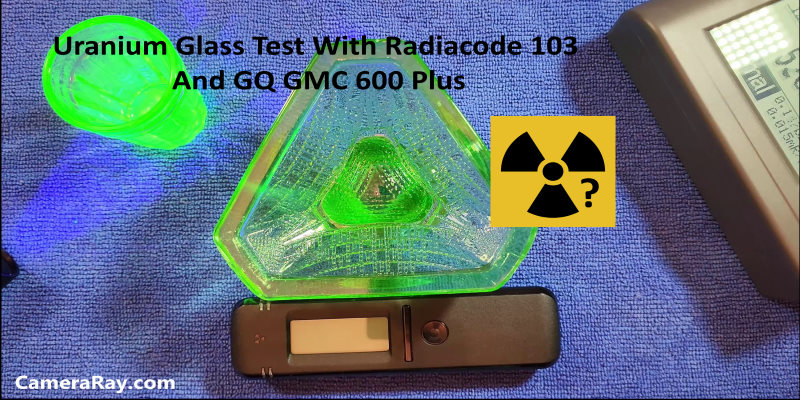
Uranium Glass Test With Radiacode 103 And GQ GMC 600 Plus Geiger Counter.
I test to see if I can detect Uranium Glass with the new Radiacode 103 radiation detector and the GQ GMC 600 Plus Geiger Counter. I find out which of the two counters are best for finding radioactive glassware.
Uranium glass, a unique type of glassware infused with uranium salts, has fascinated collectors and enthusiasts for decades. Its most striking feature is its ability to glow a vivid green under ultraviolet light, thanks to the uranium content. While uranium glass is generally considered safe to handle, it’s always intriguing to confirm its authenticity and uranium content. In this blog, we’ll explore how to detect uranium glass using a black light and a Geiger counter, turning this quest into an exciting and educational adventure.
Understanding Uranium Glass
Before diving into detection methods, let’s briefly understand what uranium glass is. Dating back to the 19th century, this glass contains varying amounts of uranium, which gives it a yellow-green to green-blue coloration. The level of uranium can range from trace amounts to about 2% by weight. Uranium glass comes in various forms, including vases, plates, and decorative items.
Using a Black Light to Detect Uranium Glass
A black light, or UV light, is a simple and effective tool for detecting uranium glass. Here’s how it works:
Find a Dark Environment: To see the glow effectively, you need a dark room or a setting with minimal light interference.
Safety First: Wear UV-protective glasses. While a black light isn’t harmful, prolonged exposure to UV light can be damaging to your eyes.
Shine the Black Light: Direct the black light onto the glassware. Uranium glass will fluoresce or glow a bright neon green under UV light. This is due to the uranium content reacting to the UV light.
Compare and Contrast: If possible, compare with a piece of non-uranium glass under the same light to see the difference in fluorescence.
Remember, while most uranium glass will glow under a black light, some pieces with very low uranium content might not fluoresce as strongly.
You can find the correct Darkbeam UV 365nm Blacklight flashlight for testing here.
The RadiaCode 103 here
The GQ GMC 600 Plus Here.
Using a Geiger Counter for a More Scientific Approach
A Geiger counter, an instrument used for detecting and measuring ionizing radiation, can also be used to confirm the presence of uranium in glass. Here’s how:
Safety First: Ensure you know how to safely operate a Geiger counter. While the radiation levels in uranium glass are typically low, it’s crucial to handle any radioactive material with care.
Calibrate the Geiger Counter: Make sure your Geiger counter is calibrated and functioning correctly.
Measure the Glass: Bring the Geiger counter close to the glassware. A noticeable increase in the count rate compared to the background radiation level indicates the presence of uranium.
Interpreting Results: Understand that the Geiger counter measures radiation, not specifically uranium. However, an increased reading is a strong indicator of uranium in antique glass pieces, given their known composition.
Precautions and Tips
Handling: While uranium glass emits radiation, it’s generally considered safe for handling and display. However, it’s advisable not to use it for food or drink consumption.
Identification: Not all green or yellow glass is uranium glass. The black light and Geiger counter tests are essential for accurate identification.
Buying and Collecting: If you’re a collector, bringing a portable black light when shopping for antique glass can be a handy trick.
Wrap-up
Detecting uranium glass with a black light and a Geiger counter is not just about confirming the presence of uranium; it’s about connecting with history and science in a tangible way. This activity can be educational, fun, and a great conversation starter. Whether you’re a seasoned collector or just curious about this glowing glassware, these methods are sure to add an extra layer of excitement to your exploration.
Remember, the glow of uranium glass is a window into a fascinating part of both scientific and artistic history. So, the next time you come across a piece of vintage glass, you’ll have the tools and knowledge to discover if it’s just an ordinary item or a glowing piece of history.